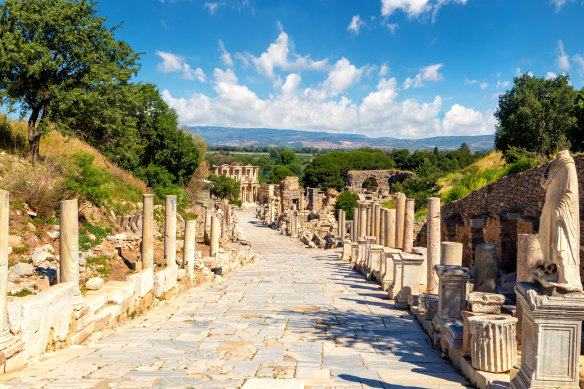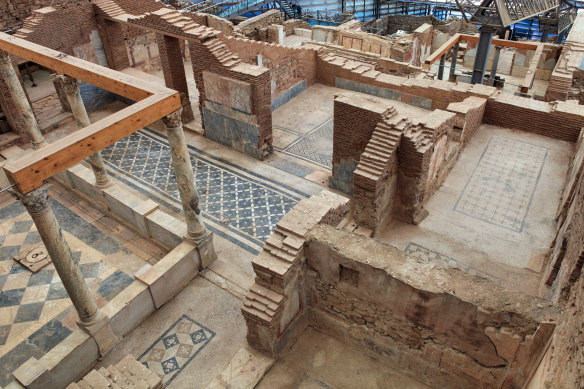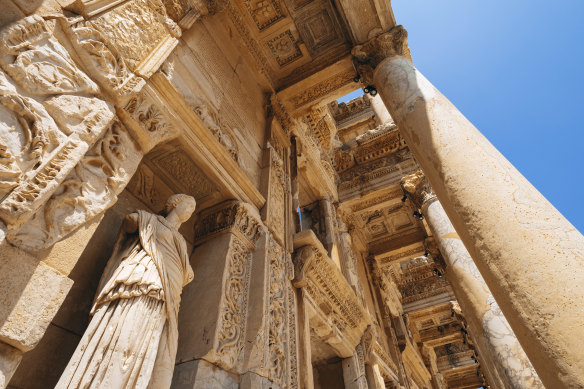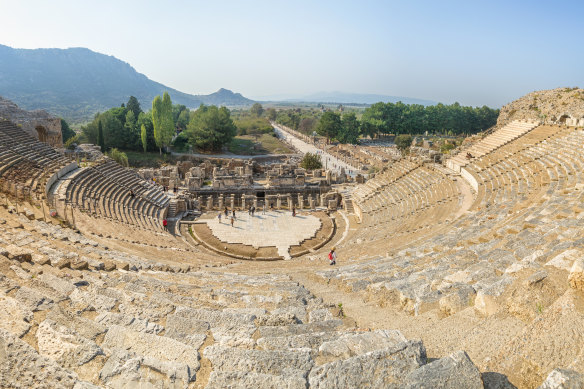Seven secrets of the Mediterranean’s best-preserved ancient site
This Greco-Roman Turkish trading city is the Mediterranean’s best-preserved ancient site, and gives you a fine impression of daily life in classical times.
Take a sharp-eyed stroll down Curetes Street

The view down Curetes Street.Credit: iStock
The main street of Ephesus, lined with triumphal arches and statues, leads past important buildings. Don’t let the monumentality distract you from the detail, however. Look for sculpted flourishes such as grape leaves and flowers, ruts made by passing chariots in flagstones, the shattered remains of fountains, and chiselled lists that describe marketplace goods. Some building blocks are initialled by the stonemasons who worked on them, and walls have hollows that once held oil lamps.
Detour to the first-century toilets

The public conveniences.Credit: iStock
The Baths of Scholastica are fronted by the headless statue of the woman who paid for their restoration 400 years later. The social club for the city’s elite boasted the latest underfloor heating through terracotta pipes, some of which survive. So do the fancy marble latrines, which make for amusing photo poses. Next door is claimed to be a brothel, with a delightful mosaic floor that depicts women enjoying a drink while a mouse eats crumbs under their table.
Check out the posh Roman houses

Inside a terrace house on Curetes Street.Credit: iStock
A series of ruined first century BC luxury villas built into a hillside off busy Curetes Street is less visited because it attracts an additional entrance fee. That’s a shame. Although only foundations remain, the terrace houses give a wonderful insight into the lives of wealthy Ephesians. The first villa, which belonged to Gaius Aptius, features 35 types of marble inlaid into floors and walls, an onyx fountain, and sophisticated plumbing and steam-heating systems. Elsewhere you can admire fabulously preserved frescoes and mosaics.
Admire the decoration of the Temple of Hadrian
Only the arched facade and back wall remain of the Temple of Hadrian, built in 138, but it has an attractively delicate appearance and elaborate carvings, notably Tyche, goddess of luck, a troupe of Amazons, and a snake-haired Medusa whose evil eye warded off misfortune. The central arch showcases the architectural magic of its keystone, which has hung suspended in place without any mortar through two centuries of storms and earthquakes. Stand beneath and take your chances.
Linger at the Library of Celsus

The library – when there, look closely to see niches where library scrolls were stored.Credit: iStock
This marble library, built around 117, survives only as a facade – but a magnificently imposing one, blinding in the noonday Mediterranean sun, and rising in a double series of pillars that froth at the top like palm trees and support delicately carved pediments. Behind the pillars, four niches protect reproduction statues of the virtues depicted as robed women, two minus their heads. Look closely at the walls and you’ll see niches where library scrolls were once stored.
Clamber up the amphitheatre for the outlook

A hot climb to the back row – the amphitheatre at Ephesus.Credit: iStock
The Great Theatre is off the main tourist axis, so seldom visited by mainstream tour groups. It seated 25,000 and is the city’s best-preserved structure, albeit with a charming air of neglect: yellow daisies, thistles and poppies grow from cracks between its tiered seating. It’s a hot haul to the back row, but you get a pleasing view over the stage, along a colonnaded street, and out into biscuit-brown countryside.
Whatever you do, don’t miss Ephesus Museum
Ephesus Museum isn’t on the archaeological site but in nearby Selcuk, and goes overlooked. It’s small but crammed with wonderful statues, ivory, jewellery, medical instruments, coins and other items that breathe life into the story of the ruins. Inspect the shapely buttocks of Dionysus for the measuring dots left behind by the sculptor. Out in the garden lie sarcophagi chiselled with fruit, cupids and the faces of their former occupants.
See goturkiye.com
Sign up for the Traveller Deals newsletter
Get exclusive travel deals delivered straight to your inbox. Sign up now.